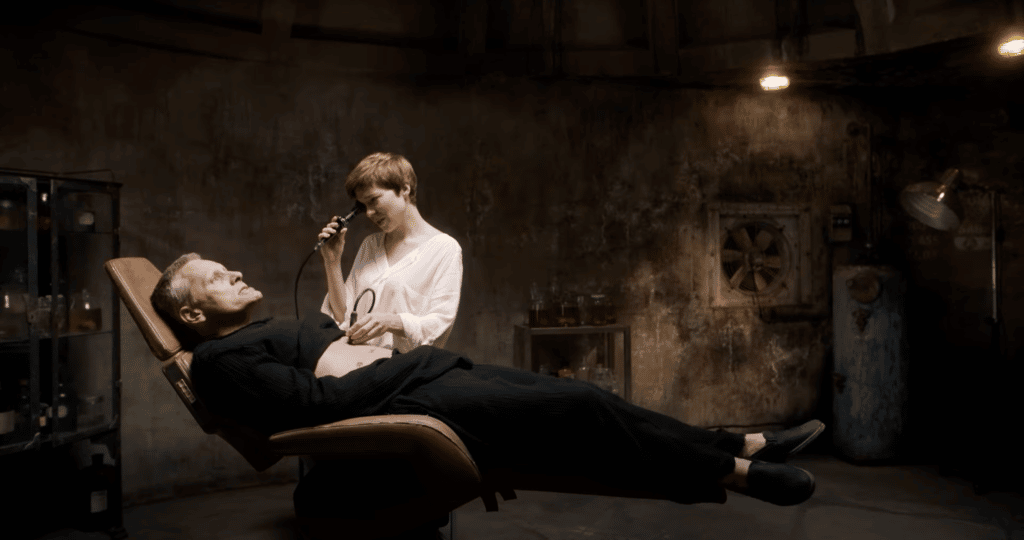David Cronenberg returns to form in an elliptical and fascinating look at a dystopia where self-mutilation replaces sex
As Marvel holds its iron grip on theaters, and Netflix seems determined to focus its dwindling profits on churning out generic action movies starring various iterations of Ryan Reynolds, cineastes lament the loss of “art” films, those outliers that, whether good or bad, generate far more lively after-movie conversation than Spider-Man ever could. And yet, right now we seem to be in the middle of a weird movie renaissance. We have the joyful weirdness of Everything Everywhere All at Once, the all too topical weirdness of Alex Garland’s Men, and the over the top spectacle weirdness of Baz Luhrmann’s upcoming Elvis. What better time could there be for David Cronenberg to come roaring back to form with some body horror weirdness in Crimes of the Future?
With the exception of straightforward crime thrillers like A History of Violence and Eastern Promises, Cronenberg’s movies are always at least a little weird, and difficult to pin down as to what it’s meant to be about (if anything at all). Like David Lynch, they’re best enjoyed if you don’t expect to come away from them expecting to understand what happened, why it happened, or what any of it means. They’re just their own individual dreamscapes, a walkabout through the concepts and imagery that fascinate David Cronenberg. Crimes of the Future, however, almost feels like a compilation reel of Cronenberg’s favorite bits, incorporating mortification of the flesh, medical trauma, future tech, and sex involving anything other than actual genitals. Despite its typically chilly, detached manner, it also feels strangely personal, though how much that might be true will likely depend on whether or not the viewer struggles with medical issues and the sense that their body is betraying them.
It’s some time in the near future, following an unexplained ecological disaster. Freighter ships have run aground and just been left to disintegrate, electricity seems to be in limited supply, and much of the population has either gone into hiding or disappeared entirely. Humans have begun to evolve past a point where they no longer feel pain, which isn’t as good as it sounds – after all, as any doctor will tell you, pain is how your body tells you that something is wrong with it. Some, like Saul Tensor (Viggo Mortensen), have developed a disease called Accelerated Evolution Syndrome, in which their bodies grow all new organs – not extra kidneys or stomachs or anything useful, mind you, entirely new organs that no one has ever seen before, and don’t seem to serve any sort of known purpose.

Like cancer cells, growing the new organs takes a toll on the body, and they must be removed before long. Despite having a condition that sounds almost superhuman, Saul is actually quite ill much of the time, and he has to both sleep in an organic pod to heal and replenish what little energy he has left, and use a skeletal “breakfasting chair” to rock him back and forth so that he can properly swallow food (as is always the case with Cronenberg’s films, the merging of flesh and technology is a creepy high point here). With the help of his partner, former trauma surgeon Caprice (Léa Seydoux), Saul has taken his condition and turned it into performance art, putting his body on display for an audience while Caprice controls robotic arms that cut into him and remove the new organ. In a world where mutilation has replaced traditional intercourse, this is akin to putting on a live sex show, and their audiences are mesmerized by it.
Saul attracts the attention of the mysterious “National Organ Registry,” run out of a grubby office seemingly by just two people: the eccentric Wippet (Don McKellar), and his even more eccentric assistant Timlin (Kristen Stewart, making some choices). Timlin in particular is fascinated to the point of arousal by both Saul, and Saul’s performance art, even making a clumsy traditional pass at him at one point (“I’m not very good at the old sex,” Saul tells her, politely turning her down).
Also deeply interested in what Saul and Caprice do is Dotrice (Scott Speedman, in an interesting post-Felicity acting career), part of a cult who have forced themselves to evolve to a point where they’re able to eat and digest plastic. Dotrice believes that his recently deceased son was born with this ability naturally, the first of his kind, and wants Saul and Caprice not just to perform an autopsy on the boy, but present it as a show. Saul’s deeply personal work seems to be on its way to becoming diluted, made on demand, and commodified as part of someone else’s “message.”
Despite its typically chilly, detached manner, it also feels strangely personal.
If you’re looking for a discernible Point A to Point B to satisfying conclusion in Crimes of the Future, you’re going to be disappointed. It’s more about concept than plot, with an ending so abrupt it’s almost like having a door slammed in your face. It exists to ask some fascinating philosophical questions: is your art still your own when someone else is demanding you create it? Is there a moral issue involved in self-mutilation as public consumption? Is there anything more sinister than an “agency” monitoring what people do to their own bodies?
Needless to say, this should not be anyone’s introduction to the films of David Cronenberg. It’s a little too opaque, and lurid scenes of characters moaning in ecstasy when their intestines are caressed in just the right way, or performing oral sex via surgical wound, aren’t the best jumping point. But if you’re a longtime fan, and you’ve been wondering when he’s going to get back to the Crash and Existenz-era superweird Cronenberg, he’s heard your pleas, and he’s delivered.
Viggo Mortensen, playing what seems as close to a Cronenberg proxy as any character he’s ever created (though the ever elliptical Cronenberg would almost certainly deny it), brings an inordinate amount of humanity to someone who’s essentially both a miracle of science and a monster. Saul might not be able to feel pain, but he’s keenly aware that his body is falling apart, and that each new piece of art he creates takes a little more away from him. His mortality looms over the complicated relationship he has with Caprice, overlapping lovers, caregivers, artist and muse, and doctor and patient (their obvious age difference also add an element of aging father and dutiful, fretful child). Caprice worries about how much more work Saul has in him (literally), but knows that loving him means letting him continue to do it.

Though she’s not in it quite as much as the trailers would have you think, Kristen Stewart is having a wonderful time here, playing a character who isn’t cute and quirky weird, but uncomfortably weird. Speaking in a breathy, often barely audible voice and rarely able to make eye contact with anyone, she acts as though she’s spent her whole life in her sad little office, and meeting Saul has instantly given her life meaning and purpose. She wants to be an artist too, but she doesn’t want to make her own art – she wants to do exactly what Saul does, preferably with Saul himself.
Gruesome, strangely erotic, and unexpectedly empathetic, Crimes of the Future will connect on different levels for different viewers. Some will just see it as a weird, bleak gross-out. Others will see it as an artist’s manifesto, while still others, such as myself, will see it as an acknowledgment of the body as both a work of wonder, and something that will let you down, no matter how much work you put out into the world. Make what you can, while you still can.
Crimes of the Future is now playing in theaters.